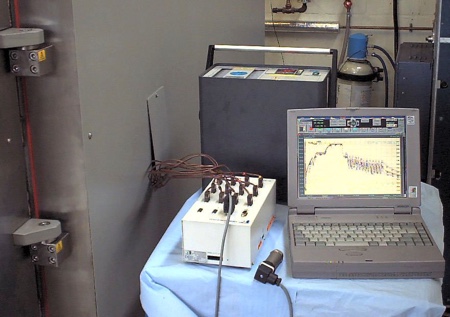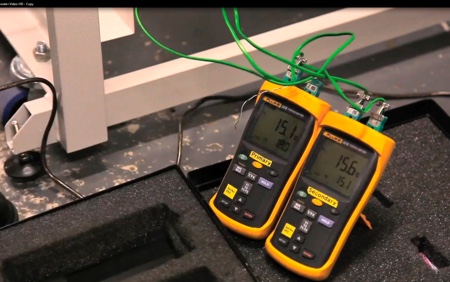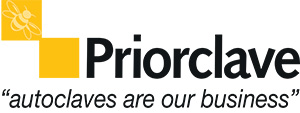The purpose of an autoclave in cleanrooms, educational establishments, pharmaceutical research and test laboratories as well as manufacturing is singularly that of destroying any micro-organisms in a load – whether that be the petri dishes and glassware used in lab processes such as culture growth, or discarded waste or clothing. The overall objective is achieved through sterilisation, which is designed to render items safe, ready for subsequent disposal or re-use.
With such importance placed on the autoclave how can the user be certain that it has achieved the required sterilisation? Improperly autoclaved materials result in contamination, lost time and wasted money – and much worse in extreme circumstances.
Although a series of tests carried out in the 1950s by the Medical Research Council established the times and different temperatures required to achieve sterilisation, there is no simple formula for how long a certain item needs to be autoclaved to achieve sterility. Consideration must be given to the type of primary container (the beaker, flask or packet), the volume of liquid, amount of solid material and any secondary container such as a tray surrounding the primary container.
Cycle times will vary with the composition of the load, therefore it is important to determine the appropriate time requirement. The contents of the autoclave will heat more slowly than the autoclave itself so when the set sterilising temperature is reached what temperature have the contents reached? It could be assumed that a time of 30 minutes is a sufficient safety margin and most of the time that would probably be right – but what if it is not?
As the luxury of sterilising individual items in ideal laboratory conditions is often not available, it is necessary to think about the variables that can affect the time needed for an autoclave to reach sterilising temperature and to achieve complete sterilisation.
1. Secondary containers: Plastic or steel containers (trays) are commonly used to hold material during autoclaving to contain spills. These containers will alter the nature of the autoclave run. Plastic containers, although usually much cheaper than those custom-made of stainless steel, will increase the autoclaving time needed; plastic is a good insulator whereas stainless steel is a better conductor of heat, so the run time will be a little faster.
2. Volume: Generally, the volume of liquid per container is a more important consideration than the total volume. A 2L flask containing 1L of liquid takes longer to sterilise than four 500mL flasks each containing 250mL of liquid.
3. Load type: Water sterilises faster than agar growth media, and plastic petri dishes pose an ever greater challenge for complete sterilisation as they melt during autoclaving. Metal objects are easier to sterilise due to their better heat conductivity.
4. Autoclave loading: Care should be taken to ensure items are not packed too tightly. The sterilising agent in an autoclave is saturated steam, which sterilises roughly seven times faster than air at the same temperature. It is therefore vital for effective sterilisation to remove all air and replace it with steam.
Much attention must be given to loading the autoclave to ensure good heat/steam penetration. Avoid overloading the chamber or placing bags in the chamber that are too large – leave room between bags, bottles, etc. for steam circulation and air removal. If the autoclave is very full (or a tray full with bottles), the treatment time will need to be considerably increased.
This list highlights a few of the vagaries of achieving the very best level of load sterility. To ensure fulfilment of a sterilisation process calls for validation and performance qualification (PQ) for each and every different load. These tests should be carried out only by suitably qualified and experienced personnel.
For the results to be recognised, the methods used and the calibration of the equipment should be regulated by a recognised body. In the UK, this is carried out by the United Kingdom Accreditation Service (UKAS), the sole organisation recognised by the UK government to assess calibration laboratories against international criteria.
Commissioning and PQ of an autoclave and subsequent validation of the sterilising protocols is a costly and time-consuming process, both in terms of the actual procedures involved and also in analysis and review of the resulting documentation. However, the costs should be reviewed in light of human safety rather than economics – although, on the plus side, a properly set up and loaded autoclave will be faster and more energy efficient than one where large margins are added to the variables to achieve sterilisation.
Checks and assurances
Temperature monitoring: Temperature recorders, printers and built-in loggers are available for autoclaves, although these only give an indication that the autoclave itself has run correctly for the duration of the sterilising cycle. They are useful as a routine check to pick up cycle irregularities but they will not detect anomalies within the load itself during a normal cycle.
Biological and other indicators: On a day-to-day basis, the effectiveness of sterilisation of any one particular run can be checked with the use of indicators placed within the load. These include autoclave tapes and indicator strips that change colour with temperature, more sophisticated strips that change colour only when they experience the correct temperature and pressure for sterilisation, and biological indicators (BI) that contain viable bacterial spores (the most difficult things to sterilise), which can be incubated after sterilisation to check for viability.
Autoclave validation: Sterilisation process validation is a procedure for obtaining, recording and interpreting the results required to establish that the process yields reliable, repeatable load sterilisation complying with predetermined specifications for sterility. It must be remembered that the load is part of the validation process, so the test load must be typical of loads actually processed. Should the user make significant changes to the load at any point in the future, then revalidation may be necessary.
Validation and routine control of sterilisation by moist heat, i.e. steam sterilisers, need be performed only at initial installation provided that the autoclave is regularly calibrated, and after certain repairs. PQ testing differs in that it should be performed regularly and routinely. For most laboratory applications validation testing is normally sufficient.
The validation process may be broken down into the following tasks:
- Installation checks
- Installation tests
- Commissioning
- Commissioning tests
- Performance testing
- Thermometric tests
- Microbiological tests
Performance testing is the only way to know what is actually happening to the load. In most cases in laboratories the installation, commissioning and performance testing of the loads to be sterilised are sufficient to meet requirements. This is normally achieved using a calibrated, multi-channel data logger so that considerable numbers of points in the load, together with salient points on the autoclave, can be logged throughout a hold time. Once qualification of the empty chamber has been accepted, load testing should be performed. Probes are placed inside typical loads and the heat transfer time is determined to measure the temperature profile during sterilisation.
Simultaneous monitoring of the chamber pressure is also useful in checking the efficiency of the air removal/replacement system.

Performance testing
Analysis of these results may point to problems in the set-up of the autoclave or in the way the load is contained. Significant differences can be seen, for instance, between glass and plastic bottles or plastic and metal discard containers, or single and double bagged discard loads.
A good calibration laboratory will consider and discuss these factors with the customer prior to the engineer arriving. However, once the performance qualification is done, calibration alone is often sufficient thereafter – at least as long as the load does not change. During the load testing, BIs may also be placed in the load to determine if sterilisation is in fact taking place.
IQ/OQ/PQ
Where the performance of the steriliser is critically important, a fully documented and recorded purchasing and approval process is used. This is known as IQ/OQ/PQ within the pharma industry and essentially the same process is involved in the Health Service in the UK.
The first part of this process involves a detailed specification from the purchaser to which the supplier can respond with the expected performance of the steriliser. Should the purchaser decided to buy on the basis of this response, this specification forms the core of the following tests and procedures. The process, if operated correctly, ensures that both parties are aware of what the steriliser is and how it must perform.
IQ refers to Installation Qualification while Operational Qualification (OQ) is defined as ‘obtaining and documenting evidence that the installed equipment operates within predetermined limits when used in accordance with its operational procedures.’ Autoclave OQs commonly test or verify items such as cycle operation and programming instructions, safety and alarm testing, error reporting, empty chamber temperature profiling and chamber temperature limits/specifications, air removal testing, leak testing, temperature control anomalies, full cycle, full load temperature profiles (if proposed full cycle exposure time is known), and determination of any hot or cold spots within the chamber.
PQ comprises a series of tests which establish that the installed and properly operating autoclave will process efficiently and effectively the user’s desired chamber loads to the specified sterility assurance level (SAL).
The primary goal for the commonly employed overkill validation is that the user needs to complete three consecutive successful half cycles to qualify their proposed full-cycle exposure for routine processing of sterilisation loads. If, for example, there was no BI growth for the three test cycles at 10 minutes exposure at 121°C, then a 20 minute exposure at the same temperature would be adequate for routine daily processing, assuming all other aspects or requirements of the IQ/OQ/PQ are successful, documented, reviewed and approved.
Calibration and maintenance
Calibration determines the accuracy of the autoclave measurement systems by measuring the actual temperature inside when a given temperature is set. The electronics may be wrong, the temperature probe may be damaged, the pressure gauge (a useful backup) may also be wrong, etc. The accuracy of the timer should also be checked.
In extreme cases calibration, particularly if a UKAS laboratory is employed, provides a powerful demonstration in a court of law that due diligence has been properly exercised. It shows that ‘all reasonable care’ has been taken. On a day-to-day level, (whether any performance testing has taken place or not) calibration is a useful way of ensuring that all is working as it should and that any assumptions made in the settings of the equipment remain valid.

Temperature calibration checks being carried out
A calibration engineer will insert a calibrated probe into an autoclave and run it at a set temperature, taking sufficient readings. The actual procedures used will vary from company to company but all UKAS accredited calibration laboratories will work to approved procedures. The data is then used to produce a calibration certificate. The engineer may also attach seals to prevent access to areas that allow the calibration to be altered.
Calibration does not always include adjustment of the autoclave controls. Often the manufacturers’ control software is not accessible to untrained, third party engineers, for obvious reasons. If the autoclave cannot be adjusted and is significantly out, then the set temperature or time can be adjusted to compensate for the difference by using the data on the calibration certificate. If for any reason adjustment of an autoclave is not required the service engineer should be informed – preferably beforehand.
Why calibrate?
Is it worth the risk of not knowing if sterilisation has taken place properly? And, in this litigious world, is it worth the risk of the autoclave not being covered by a calibration certificate?
Without regular calibration any performance testing or validation work will become invalid.
The maintenance intervals between PQ tests should be determined based on documented experience and the need, type and previous performance of the autoclave. Regular maintenance such as gasket inspection, and cleaning of the chamber should be performed at the manufacturers recommended intervals and a full service should be performed at least annually, as should the safety check of the pressure vessel.
Any repairs or modifications of the unit may require complete, or at least partial, recommissioning of the autoclave, including full PQ tests.
The results of all commissioning tests and PQ tests should be fully recorded, reviewed, accepted and archived by the relevant personnel in the organisation that uses the autoclave. These results may be recorded on suitable worksheets and certificates may be issued by third-party organisations that perform such tests.
Validation and PQ are an approval status that the autoclave is fit to use. Should the temperature in items being sterilised not reach the set temperature for the required time, not all spores will be destroyed. Validation is therefore required to ensure that the autoclave is operating correctly and that complete sterilisation is being achieved.
Regular calibration will also ensure that the initial expenditure on performance testing retains its value.





